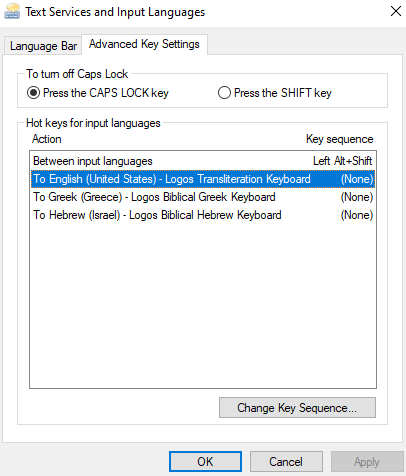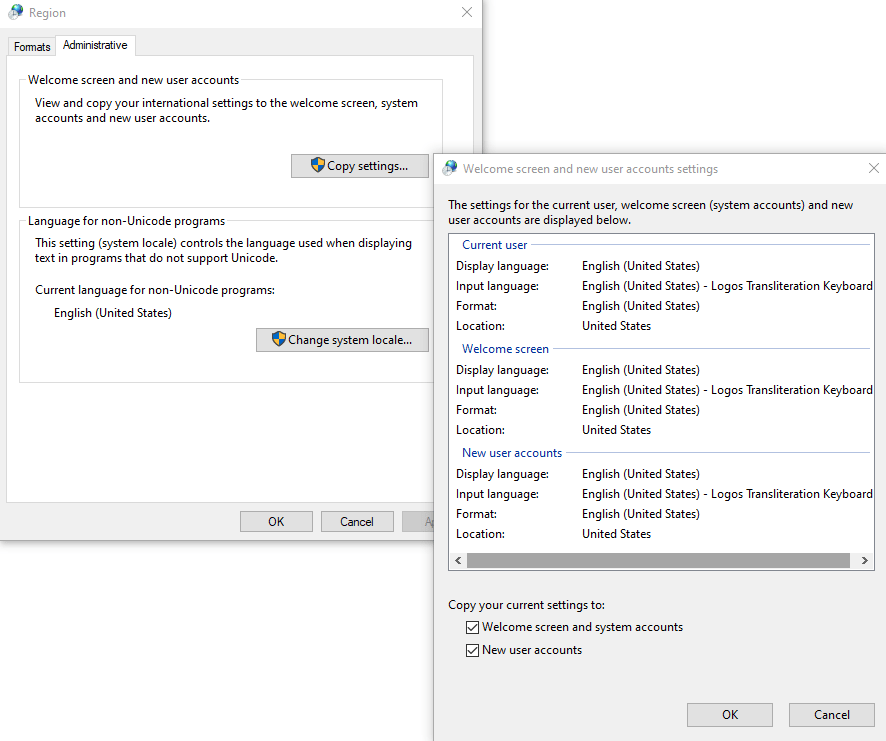In biblical studies, if you’re writing anything at all technical, you’re going to need to type text in different languages.1 That’s much easier now than it has been thanks to the wonderful invention of Unicode.
You can now have multiple different input language keymaps for one physical keyboard. So, you can use the keys lo/gos to type λόγος.
And you can specify keyboard shortcuts for switching among the different input languages. For example, you might use
- Alt+Shift+2 to start typing in Greek,
- Alt+Shift+3 to start typing in Hebrew, and
- Alt+Shift+1 to start typing in English.
The only problem is that, if you’re working on Windows 10 (and possibly still in Windows 11), Windows has a propensity to “forget” which keyboard shortcuts you’ve selected.
You can still change input languages in other ways, so it’s not a huge deal when it happens. But given the number of times you’ll change the language you’re typing over the course of a given document, degree program, or career, it’s helpful to make this change as frictionless as possible.
Fortunately, it’s comparatively simple—though not at all obvious—to get Windows to remember what shortcuts you want to use. To do so, you’ll
- select what keyboard shortcuts you want to use to change input languages and then
- save those in an additional place so Windows will continue using the same shortcuts.
Select Your Keyboard Shortcuts
To select your keyboard shortcuts to change input languages,
- Open the Start menu, type “Advanced keyboard settings,” and open that window.
- Click the link for “Input language hot keys.”
- Choose the input language you want to assign a shortcut to, and click “Change Key Sequence ….”
- Repeat this process for all the input languages you want to assign a shortcut to.
- When you’re done, click “OK.”
Save Your Shortcuts in One More Place
Then, to keep Windows from forgetting what to do with these shortcuts,2
- Open the Start menu, type “Control Panel,” and open the Control Panel.
- Click the link to “Change date, time, or number formats.” The Region dialog box will then display.
- On the Administrative tab of the Region dialog box, choose to “Copy settings …” under “Welcome screen and new user accounts.” The Welcome screen and new user accounts settings dialog box will then display.
- At the bottom of this dialog box, choose to copy current settings to both “Welcome screen and system accounts” and “New user accounts.”
- Click “OK,” and then click “OK” in the Region dialog box.
That’s it. Windows will now let you use the keyboard shortcuts you’ve chosen whenever you’d like and won’t act like it’s forgotten them.
Something to Be Aware Of
The one hitch is that, if you go back to where you specified the keyboard shortcuts, you might find that Windows says that there isn’t a keyboard shortcut assigned—even though it acts like there is.
That issue won’t affect how the shortcuts function. But if you want to change one of your shortcuts, you may have to set them all up again.
You’ll probably only want to change shortcuts right at the beginning as you’re starting to use them and figuring out what’s most natural for you. After that, you’ll want to stick with the same ones so that your “muscle memory” can work for you.
But the fact that Windows might make it look like it’s forgotten your shortcuts—even though it actually remembers them—is something to be aware of if you do need to change these shortcuts at some point.
Conclusion
Keyboard shortcuts can make the process of changing input languages still easier than it already is. Windows might take some extra coaxing so that it remembers your shortcuts properly. But for a task you’ll perform thousands of times, it’s well worth taking a few seconds to streamline it as much as possible.
Header image provided by NordWood Themes. ↩
For this process, I’m grateful to the discussion at “Windows 10 Loses Settings of Keyboard Layout Shortcuts (Hotkeys for Input Languages),” forum, Stack Exchange, 6 August 2016. ↩



Leave a Reply